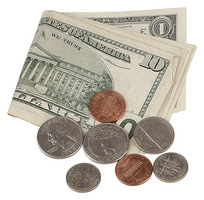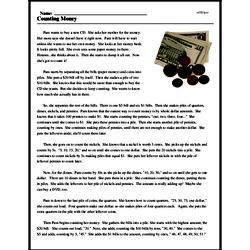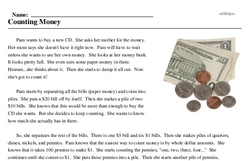Counting Money
Pam wants to buy a new CD. She asks her mother for the money. Her mom says she doesn't have it right now. Pam will have to wait unless she wants to use her own money. She looks at her money bank. It looks pretty full. She even sees some paper money in there. Hmmm...she thinks about it. Then she starts to dump it all out. Now she's got to count it!
Pam starts by separating all the bills (paper money) and coins into piles. She puts a $20 bill off by itself. Then she makes a pile of two $10 bills. She knows that this would be more than enough to buy the CD she wants. But she decides to keep counting. She wants to know how much she actually has in there.
So, she separates the rest of the bills. There is one $5 bill and six $1 bills. Then she makes piles of quarters, dimes, nickels, and pennies. Pam knows that the easiest way to count money is by whole dollar amounts. She knows that it takes 100 pennies to make $1. She starts counting the pennies, "one, two, three, four..." She continues until she comes to $1. She puts these pennies into a pile. Then she starts another pile of pennies, counting by ones. She continues making piles of pennies, until there are not enough to make another dollar. She puts the leftovers aside; she'll count them later.
Then, she goes on to count the nickels. She knows that a nickel is worth 5 cents. She picks up the nickels and counts by 5s. "5, 10, 15, 20," and so on until she comes to one dollar. She puts the 20 nickels into a pile. She continues to count nickels by 5s making piles that equal $1. She puts her leftover nickels in with the pile of leftover pennies to count later.




